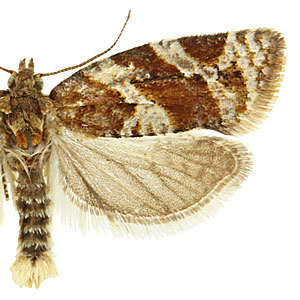Adult Recognition

FWL: 5.5-8.5 mm
Forewing ground color ranges from pale brown to silvery white. Markings are dark reddish brown to gray and usually include a well-defined median fascia and outer costal spot. Hindwings are grayish brown. Males lack a forewing costal fold.
Adults may appear similar to other species of Argyrotaenia, including Argyrotaenia velutinana and A. pinatubana. A genitalic dissection is necessary to confirm identity. Male A. velutinana have a distal, pointed projection from the median sclerotized portion of the valva that is absent in A. ljungiana. The uncus of male A. pinatubana is broader and slightly expanded distally compared to the uncus of A. ljungiana.
Larval Morphology

Late instar larvae are pale green with a yellowish brown head. The prothoracic shield is yellowish green with a black posterolateral mark and black shading on the posterior margin. An anal comb with 6-8 teeth is present.
Biology

Argyrotaenia ljungiana completes 1-2 generations in most of Europe and 2-3 generations in Transcaucasia (Caucasus Mountains). Adults are present April-May and June-July, and again in September if there is a third generation.
Females deposit eggs in masses of 40-50 individual eggs on the upper surface of leaves. Early instar larvae skeletonize the underside of leaves along the midrib. Later instars roll or fold leaves and may also feed on buds and fruits. Pupation occurs in debris on the ground, in webbed leaves, or in bark crevices. Overwintering occurs in the pupal stage.
This species is considered a pest of fruit and field crops and ornamentals in southern Europe and the European part of the former USSR. It has been recorded damaging a variety of plants, with most economic losses occuring in apple, grape, and tea.
Host plants
Larvae of Argyrotaenia ljungiana are polyphagous and have been reported feeding on a variety of plants, including many economically important species. The following is a partial host list.
| Family | Genus/species | Common name |
| Asteraceae | Centaurea L. | knapweed |
| Asteraceae | Chrysanthemum L. | daisy |
| Asteraceae | Tripolium pannonicum (Jacq.) Dobrocz. | sea aster |
| Betulaceae | Betula L. | birch |
| Ericaceae | Calluna vulgaris (L.) Hull | heather |
| Ericaceae | Erica L. | heath |
| Ericaceae | Vaccinium uliginosum L. | bog blueberry |
| Ericaceae | Vaccinium L. | blueberry |
| Fabaceae | Colutea arborescens L. | bladder senna |
| Gentianaceae | Gentiana pneumonanthe L. | |
| Lamiaceae | Lavandula L. | lavender |
| Myricaceae | Myrica gale L. | sweetgale |
| Pinaceae | Abies Mill. | fir |
| Pinaceae | Larix decidua Mill. | European larch |
| Pinaceae | Picea A. Dietr. | spruce |
| Pinaceae | Pinus L. | pine |
| Poaceae | Zea mays L. | corn |
| Ranunculaceae | Ranunculus L. | buttercup |
| Rosaceae | Drayas octopetala L. | |
| Rosaceae | Malus sylvestris (L.) Mill. | European crab apple |
| Rosaceae | Malus Mill. | apple |
| Rosaceae | Prunus armeniaca L. | apricot |
| Rosaceae | Prunus L. | |
| Rosaceae | Pyracantha M. Roem. | firethorn |
| Rutaceae | Citrus L. | citrus |
| Theaceae | Camellia sinensis (L.) Kuntze | tea |
| Vitaceae | Vitis vinifera L. | wine grape |
Distribution

Argyrotaenia ljungiana is distributed from Western Europe east to China and Japan.
Bradley et al. (1973) reported this species as occuring in North America; the source of this record is probably related to a misidentification of A. pinatubana as Tortrix politana (= ljungiana) by Zeller, which was then reported by Packard (1890). Freeman (1944) correctly synonymizes the Packard T. politana under A. pinatubana.
References

Bradley, J. D., W. G. Tremewan and A. Smith. 1973. British Tortricoid Moths - Cochylidae and Tortricidae: Tortricinae. The Ray Society, London, England.
Freeman, T. N. 1944. A review of the North American species of the genus Argyrotaenia Stephens (Lepidoptera, Tortricidae). Scientific Agriculture. 25: 81-94.
Ovsyannikova, E. I. and I. Ya. Grichanov. 2009. Pests: Argyrotaenia ljungiana (Thunberg) - grape tortrix. Interactive Agricultural Ecological Atlas of Russian and Neighboring Countries: Economic Plants and their Diseases, Pests and Weeds. http://www.agroatlas.ru/en/content/pests/Argyrotaenia_ljungiana/ [accessed 2 April 2011].
Packard, A. S. 1890. Insects injurious to forest and shade trees. USDA, Fifth Report of the U.S. Entomological Commission, Bulletin No. 7. 957 pp.
Razowski, J. 2002. Tortricidae of Europe, Vol. 1, Tortricinae and Chlidanotinae. Frantisek Slamka, Slovakia. 247 pp.
Photo Credits

Fig. 6: Entomart
Fig. 7: Gyorgy Csoka, Hungary Forest Research Institute, Bugwood.org








